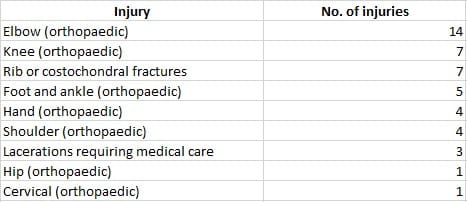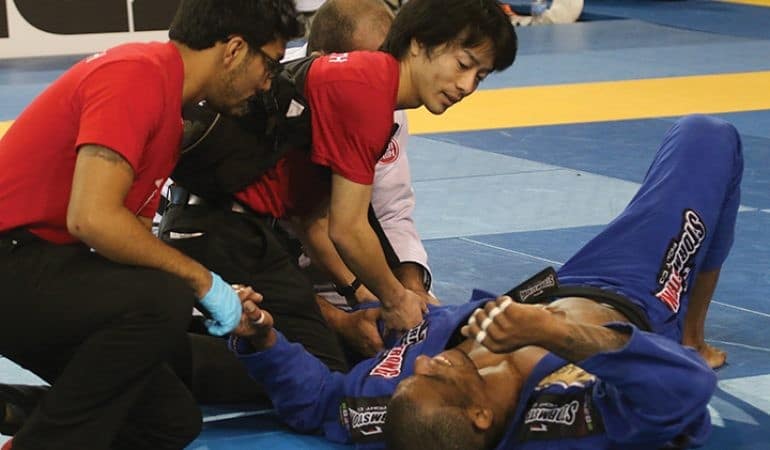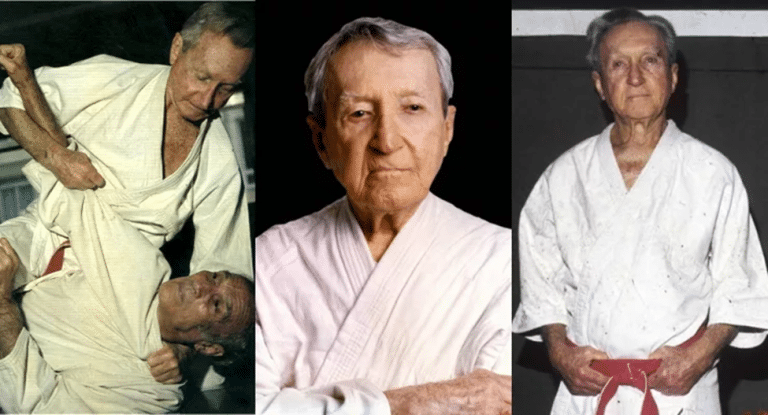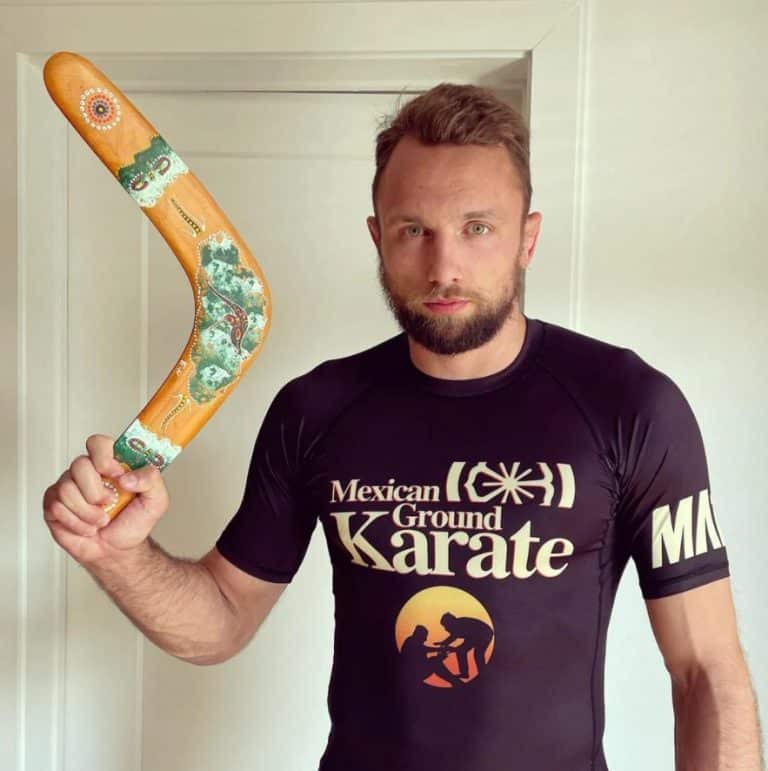The 7 Most Common Injuries in Brazilian Jiu-Jitsu
Injuries are a part of any sport. And Brazilian Jiu-Jitsu is no exception. However, there are some injuries that are more common than others. In a study that involved almost 2500 BJJ matches in competitions, here’s a breakdown of the most common injuries people sustained by BJJ practitioners:

In this article, we will discuss the seven most common injuries in BJJ.
Types of Injury
Injury types in Brazilian Jiu-Jitsu (BJJ) can be classified into two main categories: acute and chronic injuries. Acute injuries are the result of an immediate trauma to the body, such as a fall or an impact to the head. This type of injury is typically caused by a single incident and can include sprains, strains, bruises, cuts, fractures and dislocations. Chronic injuries tend to be the result of repetitive stress on the body over time. Common examples of this type of injury include tendonitis, bursitis, arthritis, muscle tears and plantar fasciitis.
Acute injuries are often best treated with a combination of rest and ice along with physical therapy. This approach helps accelerate healing while reducing pain and inflammation. It’s also important to take note of any activities that may have contributed to the injury so that they can be avoided in the future. In severe cases where an individual experiences broken bones or other serious issues medical attention should be sought immediately following the incident.
Chronic injuries require longer-term treatment strategies such as stretching, strengthening exercises and regular massage therapy. Rest is also important since it allows for tissue repair, reduced inflammation and prevents further injury from occurring due to overuse or fatigue. Whenever possible modifications should be made if specific movements or techniques are causing undue stress on certain parts of the body. If issues persist even after rest and modifications have been made then seeking professional advice may be necessary as further treatment options could include medications or surgery depending on the severity of the condition.
No matter what type of injury one experiences, it is important to seek out appropriate medical care so that proper diagnosis can occur as well as proper treatment plans can be implemented in order to avoid prolonged discomfort or permanent damage from occurring due to neglecting necessary steps towards recovery due to BJJ related injuries.
Injuries to Muscles
These can be caused by a variety of factors including improper technique, overtraining or repetitive motion. Injuries typically involve strains, tears, sprains or fractures. Muscle strain is one of the most common types of injury seen in BJJ due to the frequent use of various locks and holds as well as throws which require significant strength from the user.
Injuries to Ligaments, Tendons, or Nerves
Injuries to ligaments, tendons, and nerves can also be experienced while doing BJJ. This includes damage to the rotator cuff in the shoulder as well as sprains of the elbow or knee. Nerve issues such as cervical radiculopathy can also occur due to direct trauma or pressure on a nerve root resulting in pain and numbness in the arms or legs.
Joint sprains usually occur when there is an unnatural twisting or torquing of a joint beyond its normal range of motion. This can cause damage to ligaments that hold the joint together, resulting in painful inflammation. Tendinitis is another injury commonly experienced due to excessive tension on the tendons that connect muscles to bones. Lastly, fractures occur when the bone is broken or cracked due to sudden impact or overuse.
The Most Common BJJ Injuries
The most common injuries in BJJ are strains, sprains, fractures, tendinitis and nerve compression. Strains and sprains occur when the muscles or ligaments are overstretched beyond their normal range of motion.
Lower Back
There are a few common causes of lower back injuries in BJJ. One is when someone doesn’t have enough strength to keep their opponent from pushing them over. This can happen especially if the other person is bigger and stronger than the injured person. Another cause can be spinal twists, or when someone hyperextends their back while in a back mount position.
Fingers
In Brazilian Jiu Jitsu, gripping is one of the most important things. You need to be able to grip someone to control them. That is why many people have to tape their fingers. This helps them train without getting injured. Finger injuries are common in Brazilian Jiu Jitsu, including bone fractures, finger dislocations, finger sprains or hyperextensions, jersey fingers, boutonniere deformities, and bursitis.
Shoulders
Our shoulders are also liable to undergo trauma and hyperextension that can result in rotator cuff tears, rotator cuff tendinopathy, impingement syndrome, and bursitis.
There are three common ways a fighter can injure their shoulder: shooting, armlocks, and posting. When fighters don’t keep their elbows close, shoulder injuries happen. If they resist, this can put a lot of pressure on the shoulder and in some cases can lead to injury. Similarly, if a fighter shoots too aggressively, and their opponent sprawls out too far, this can result in a lot of weight and force squarely falling onto the shoulder.
Because the shoulder is a ball and socket joint, it requires a lot of stabilizing muscles and ligaments to keep it working properly. When one of these muscles or ligaments is hurt, it can cause tightness and stiffness. When one of these muscles or ligaments is torn, the injury can be serious, especially if it is a full tear.
Neck
This is a common problem for people who don’t train regularly are neck injuries. The regular demands on your neck can cause stiffness and pain. There are some things you can do to help, like doing some low-impact neck exercises, taking it easy when you start training, and avoiding inverting (rolling your head backwards). As mentioned before, neck stiffness is often due to inflammation or stiffness further down the body, especially in the traps and rhomboids. The best way to get rid of any pain is usually through regular massages and rest.
If you twist and turn your neck often, you can sprain or strain your cervical spine. This is the part of your spine in your neck. But if the trauma is really bad, you might damage your nervous system. This can cause symptoms like tingling, numbness, and other problems that come from a “pinch nerve” in your arms, shoulders, and fingers.
Though it might not sound dangerous, this can lead to a lot of pain and make it hard to move. However, this is only a symptom that could be caused by different, very harmful problems.
Knees
The two body parts that are most prone to serious injuries in grappling are the neck and knees. There are two types of knee locks: the MCL and ACL. The MCL or medial collateral ligament is a band of tissue that helps keep your knee stable. The ACL or anterior collateral ligament is a band of tissue that keeps your knee from moving too much. If you move your knee too much, you can injure the ACL and hear a popping sound. Knee injuries tend to affect either the muscles or the ligaments that stabilize the knees.
Almost immediately after the injury, you will experience a lot of pain. The area will swell within an hour or two. It will be very hard to walk and even harder to straighten your knee.
The MCL prevents the knee from bending inward more than it is supposed to. When the ligament on the inside of the knee is stretched too much, it can tear. This is called an MCL tear. There are two types of knee injuries: ACL and MCL. The ACL is the more serious injury because it can require surgery. The MCL is less serious and may heal on its own. However, both types of injuries cause pain and other symptoms that are very similar.
While heel hooks often get the blame for causing knee injuries, arguably improper escape technique should be held responsible!
Head
Chokes and concussions are what scare most people. This is because they can cause serious damage that is sometimes irreversible. For example, you could die if you don’t get help soon or you could have permanent brain damage. Many boxers become Hall of Famers, but then they develop diseases that affect their brains. This happens because they have had many concussions.
BJJ doesn’t allow people to hit each other, and is less likely to cause concussions than other combat sport. But slamming or being slammed on the mat can still cause injuries. Furthermore, it comes to chokes in BJJ, if blood flow is stopped to the brain for several minutes it can result in permanent brain damage. Although the general practice is to tap out before losing consciousness, there are times when people applying the choke won’t notice how long you’ve been out.
If the referee or someone else doesn’t help you and give you the right care, you might end up with a carotid artery dissection or some other type of injury that can cause a lot of damage.
Why Injuries Happen
Most injuries in BJJ occur not because of the violence associated with fighting, a lack of technique, or insufficient understanding of an opponent’s strength. Instead, these incidents result from fighters’ egos causing them to be more aggressive than necessary.
Rener Gracie says that you should think of a sparring match as a tug of war with a rubber band. If you pull hard and your partner follows, the band stretches, but it doesn’t break. If your partner pulls hard and you follow, again, the band stretches without breaking. However, if you and your partner both pull hard at the same time in opposite directions, the rubber band snaps. The lesson here is that sparring sessions are meant to help you improve your technique, not beat up your opponent. Fighters need to be aware of their egos and know when to ease off. This may not prevent every injury, but it will help many fighters stay healthy.
How To Avoid Injuries?
The best way to avoid getting injured in BJJ is to understand the techniques and practice them with a partner. You should always start slowly, practice good technique, and never give up if you find yourself in a difficult situation. Also, when sparring or rolling, it’s important not to let your ego get the best of you. It’s better to take your time and learn than risk injury for the sake of winning.
Finally, you should always pay attention to what your body is telling you. If something feels wrong or hurts too much, then stop immediately. This may mean forfeiting a match or taking a break from BJJ training. But this will help you stay safe and healthy so that you can continue enjoying BJJ for years,
The Importance of Ego Control
Recognizing that you are not perfect is the first step to having ego control. You may sometimes make mistakes and be defeated by your opponents. This is especially true when you are sparring with someone who is less experienced than you. Even if you consider yourself a master, your opponent may surprise you and put you in a hold that you weren’t expecting. You then have two choices:
- Recognize that you are beat, tap out, and learn from your mistake.
- Fight like hell and get out.
People who choose to spar to improve their skills may get a little bit of an ego bruise, but they will quickly be able to get back on their feet. They will fight another day. More importantly, they will likely be able to train consistently and stay at the top of their game because they won’t be frequently sidelined by injury. People who choose the second option may be able to keep their pride, but they risk losing control of the situation. This happens because they treat even a sparring session like it is a title fight. They are more likely to pull that rubber band to the snapping point, which could lead to them or their partner getting injured.
Banned/Illegal Moves Are Forbidden For A Reason
To start, you should identify which moves are most dangerous in Judo, BJJ, Luta Livre, Wrestling, or any other grappling-based fighting style. Common sense dictates that these disciplines understand particularoves that could be deadly or end a fighter’s career.
Some dangerous moves in Jiu Jitsu are cervical neck cranks, flying arm-bars, flying triangles, jumping or flying guard pull, kani basami or scissor leg takedowns, bicep slicers, and double underhook stack passes. These moves can be dangerous if you’re not careful.
If you are a beginner, it is important to follow the rules in the gym and to participate in a safe environment. This will help you avoid common injuries.
Avoid Explosive/Strong/Immature Partners
We’re all aware of the memes and stories about people who are too competitive or excited when they start learning BJJ. It’s not your fault if someone has a competitive background, and it’s not your responsibility to give them a hard time when you roll. Remember that this is especially true for people who are bigger than you.
If you don’t want to get hurt, you can refuse any sparring session. Before you start sparring with someone, watch how they fight with other people. You will be able to tell if they have a college football or wrestling background. If you are new, your instructor will make sure to pair you up with someone who is more experienced so that you can learn properly.
Even experienced MMA fighters like Ramsey Dewey encourage people to learn how to refuse because they experience people going too hard on them. Ramsay has had his skull fractured from his fighting career, and now teaches people MMA.
While he’s still an expert in the sport, he can’t possibly sustain headshots without risking serious permanent damage.
If someone is going too fast during a headshot, Sensei John will stop sparring with them. They need to go find someone else who can match their speed. That way they won’t get hurt.
It’s important to be honest with yourself about your abilities. If you’re not comfortable saying no, then you’ll end up getting hurt and won’t be able to do anything. Find a group of people that you are comfortable communicating with and who understand your limits. These will be the only people you roll with.
*Important: It is imperative that you tell your instructor as well as anyone you roll with if you have any medical condition, psychological trauma or specific difficulties that you can’t compromise on*.
In a BJJ gym, you should feel comfortable training with your partners. If you don’t feel comfortable, talk to your instructor. He or she will help you. If you don’t want to roll with someone for any reason, you can refuse. Older practitioners are encouraged to refuse to roll with explosive new guys to avoid getting injured. If the instructor does not seem helpful, find a new gym with understanding and compromising practitioners.
Train for Flexibility and Strength
There are some dangerous moves in jiu jitsu that are not part of normal routines. This means that your body will be moving and using muscles and bones in ways that are different from what you’re used to. You need to train your body to be able to withstand some damage. This means practicing moves like shrimping and bridging, as well as learning how to survive neck cranks (hello stiff neck) and muscle extensions.
There’s no denying that people who are more flexible and athletic can adapt to various situations better. That’s why it’s important to engage in workouts that improve flexibility and strength. Strength training is not only beneficial for building stronger muscles, but it also helps add mass which protects your ligaments, bones and internal organs from damage.
Hygiene
It’s essential to realize that not practicing good hygiene will result in both health problems and injuries. Whether you’re wearing a BJJ Gi or rash guard, you must wash your clothing every time after class. All sorts of dangerous microbes, from bacteria and viruses to fungi, can spread among people rolling together in a dojo.
If you have the flu, skin infections, or any other viral or contagious problem, you should stay away from the mats and observe from a distance. It may be difficult, but just try to convince yourself that it is better not to infect everyone you roll with.
I have written a guide on how to wash a gi right here.
Always Invest In Physiotherapy Or Chiropractors
Massages and physiotherapy appointments can help you relax your muscles and ease the tension that builds up. Sometimes, jiu jitsu athletes have to go through moves that aren’t necessarily painful or putting you to sleep, but are sowing the seeds for long-lasting pain. Physiotherapists are medical professionals who can identify and treat injuries. A common example of this is the mallet finger. People often don’t recognize that they have an injury if it just hurts a little bit. For example, if someone’s finger only bends at the tip, they might not think anything is wrong. But it’s important to get checked out by a professional just in case.
But almost 3-4 weeks later, patients show up with crooked fingers and wonder what’s wrong.
Like all combat sports training, BJJ can cause you to have musculoskeletal problems that aren’t permanent or fatal, but can be very painful and long-lasting if you don’t comply with the doctor’s orders.
Sustain, Learn, Adapt, Recover And Avoid
Everyone makes mistakes and gets injured sometimes. It’s important to learn from your mistakes, make sure you don’t make the same mistake again, and give yourself time to recover without stopping your training altogether. This is often easier said than done though, because many people have problems following this plan.
Injury can be very traumatic for people who practice Brazilian Jiu-Jitsu. This can be true for both people who have been injured and people who have seen someone else get injured. It can be hard to adjust to the injury and continue training safely while you are recovering.
You need to take care of yourself and get better first. Then you should learn what happened and try to avoid the same thing from happening again. After that, if your doctors say you are okay, you can start training again.
Gordon Ryan, one of the best submission grapplers in the world, told his story about going through surgery to fix a ligament. Gordon recommends putting on your brace or bandages for even more than the medically prescribed period to ensure complete recovery. You can’t risk putting pressure on injured limbs, ligaments, etc. and thus you should train with people who understand what you’re going through and what you can and can’t work on.
Tap Early
Many people think that they won’t get injured if they don’t tap out during a submission attempt. This is not true. In fact, almost every other day someone gets injured because they didn’t tap out in time. You need to understand that with every submission, the person applying it will never know when your body’s limit is until everyone in the gym hears the snap.
Always remember that it is the individual’s responsibility to accept and concede defeat. However, what if you couldn’t go home with a win? In this case, you would be returning with your health and possibly your life- which is worth more than any belt or prize.
Always tap out, even if you think you can get out. If you don’t tap and are caught, it’s tough luck! Start again and make sure you don’t get to the same point again.
People don’t realize that even if someone seems to be sleeping after a choke, they might be at risk for a stroke. This can be fatal or cause permanent damage if proper aid isn’t administered in time.
Customarily, white belt Jiu-Jitsu students make the mistake of not tapping early enough and being too proud to admit defeat. By doing this, they only cause themselves more pain in the long run. In order to avoid this, tap as soon as possible and always be aware of your opponent’s ego. It is better to let someone have the win than go home feeling guilty or hurt.
Too Much Training
There is such a thing as too much training. This is when one of our vertebrae slips out and onto the vertebra below. When this happens, you can get injured more easily. You are also putting yourself at risk of problems like spondylolisthesis that can result in mild to excruciating lower back pain.
The next time you feel like your back is giving you a hard time for consecutive days, don’t roll and immediately report to a doctor.
Diet
Your diet affects how you recover from injuries. Sugars and fast food are the worst for you because they do not have the protein and carbs your muscles need. If you don’t eat items that have nutrients like milk, you might be depriving yourself of essential calcium and vitamins that are crucial in recovery.
Your diet will affect how you recover from injuries. Good diets will help your body be stronger and have more energy. This will help you avoid common injuries in BJJ and make you faster and stronger.
Modifying Your Training
Knowing when not to fight is important. For people who have been injured, it is best to rest and not spar with anyone until you have healed. You should come to class and take notes, learning from other people. As you finish healing, you should take things slowly. If your body is not healed yet, you should not try to train at 100%.
If you have an injury, avoid positions that will aggravate it. If your lower back is injured, don’t do back mount or closed guard. If you have a neck injury, don’t try to post with your head. If you have a shoulder injury, tuck your injured arm into your belt so you can roll more easily and avoid reflexively trying to post with your injured arm.
It is important to be comfortable with your partner when you spar. This means two things: first, you should spar with someone who is either close to your size or slightly smaller than you. Second, it means being sure your partner is someone with whom you have a good relationship so you can ensure things stay friendly.
Remember, a sparring session is never life and death. This means that you should always try your best, but don’t take it too seriously.
Takeaway: Is BJJ Safe?
Yes, Brazilian Jiu-Jitsu is generally safe when done properly. It is important to remember that you need to tap out early and not be too proud to admit when you are in a bad spot to avoid a major injury.
Additionally, it is important to be aware of your body’s limits and know when it’s time for rest or extra caution. This way, severe injuries will become an exception.
Finally, modifying your training based on any existing injuries can help keep yourself healthy throughout your martial arts journey. So, the next time you step onto the mat, make sure safety comes first!
FAQ
How Common Are Injuries in BJJ?
Moriarty et al and Petrisor et al investigated BJJ-related injuries in both training and competition and found that injuries occur commonly in BJJ: The studies reported a high injury prevalence (9/10 athletes sustaining at least 1 injury) 21 and a 6-month injury incidence rate of 59.2%
What Are The Most Common BJJ Injuries?
A recent study found from surveying over 166 BJJ gyms in the U.S that most common injuries occur at the hand and fingers, followed by the foot and toes, followed by the arm and elbow. Anyone who trains BJJ knows that fingers and toes can easily get banged up.
How To Do BJJ Without Injuries?
Here are some tips to help you prevent the most common BJJ injuries: Warm up and stretch before hard training. Tap as soon as you feel that a submission hold is properly applied. Use control during all of your practice sessions and sparring matches.
how to train hard but prevent injuries bjj?
- Check your ego at the door and tap early.
- Never try to muscle out of submission.
- Sparring is not a competition.
- Wash your Gi / Hygiene in the gym.
- Choose your training partners.
- Tape your fingers.
- Never miss a warmup and stretch a lot.
What Kind of Head Injuries Can Be Caused From BJJ?
As a grappling sport, BJJ puts practitioners at risk for incurring a sports-related concussion. In this retrospective survey, 25.2% of BJJ practitioners report having a concussion while engaging in BJJ in their lifetime.
judo vs bjj which has more injuries?
BJJ has a lower frequency of hip and knee injuries than Judo. The injury rates in competitive BJJ were also much lower to a very similar combat sport: Judo, where they had competitions injury rates ranging from 25.2 to 130.6 per 1000 exposures. This is due to the fact that Judo relies much more on throwing techniques than in BJJ.
My limited experience is that Judo tends to result in more severe injuries, based on observing the more experienced practitioners. Knee and shoulder injuries appear to be fairly common in Judo.





